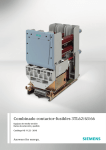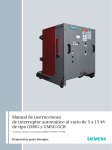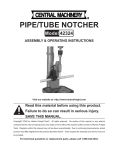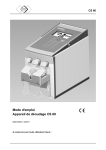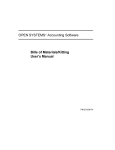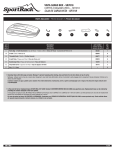Download Siemens E50001-F710-A420-X-4A00 User's Manual
Transcript
Type Vector® manual group-operated switch instruction manual Installation operation maintenance E50001-F710-A420-X-4A00 Answers for energy. Arc flash hazard and hazardous voltages. Will cause death, serious injury or property damage. Always de-energize and ground the equipment before maintenance. Read and understand this instruction manual before using equipment. Maintenance should be performed only by qualified personnel. The use of unauthorized parts in the repair of the equipment or tampering by unqualified personnel will result in dangerous conditions which will cause death, severe injury or equipment damage. Follow all safety instructions contained herein. Important The information contained herein is general in nature and not intended for specific application purposes. It does not relieve the user of responsibility to use sound practices in application, installation, operation and maintenance of the equipment purchased. Siemens reserves the right to make changes in the specifications shown herein or to make improvements at any time without notice or obligations. Should a conflict arise between the general information contained in this publication and the contents of drawings or supplementary material or both, the latter shall take precedence. Qualified person For the purpose of this manual a qualified person is one who is familiar with the installation, construction or operation of the equipment and the hazards involved. In addition, this person has the following qualifications: Is trained and authorized to de-energize, clear, ground and tag circuits and equipment in accordance with established safety procedures. Is trained in the proper care and use of protective equipment, such as: rubber gloves, hard hat, safety glasses or face shields, flash clothing, etc., in accordance with established safety practices. Is trained in rendering first aid. 2 Further, a qualified person shall also be familiar with the proper use of special precautionary techniques, personal protective equipment, insulating and shielding materials and insulated tools and test equipment. Such persons are permitted to work within limited approach of exposed live parts operating at 50 volts or more, and shall, at a minimum, be additionally trained in all of the following: The skills and techniques necessary to distinguish exposed energized parts from other parts of electric equipment. The skills and techniques necessary to determine the nominal voltage of exposed live parts. The approach distances specified in NFPA 70E and the corresponding voltages to which the qualified person will be exposed. The decision-making process necessary to determine the degree and extent of the hazard and the personal protective equipment and job planning necessary to perform the task safely. Table of contents Introduction 4-5 General description 6-7 Receiving, handling and storage 8 - 10 Installation 11 - 12 Operating handle adjustment procedure 13 Operational check out instructions 14 - 15 Maintenance 16 - 17 Note: These instructions do not purport to cover all details or variations in equipment, nor to provide for every possible contingency to be met in connection with installation, operation or maintenance. Should further information be desired or should particular problems arise that are not covered sufficiently for the purchaser’s purposes, the matter should be referred to the local sales office. The contents of this instruction manual shall not become part of or modify any prior or existing agreement, commitment or relationship. The sales contract contains the entire obligation of Siemens Energy, Inc. The warranty contained in the contract between the parties is the sole warranty of Siemens Energy, Inc. Any statements contained herein do not create new warranties or modify the existing warranty. 3 Introduction Arc flash hazard and hazardous voltages. Will cause death, serious injury or property damage. Always de-energize and ground the equipment before maintenance. Read and understand this instruction manual before using equipment. Maintenance should be performed only by qualified personnel. The use of unauthorized parts in the repair of the equipment or tampering by unqualified personnel will result in dangerous conditions which will cause death, severe injury or equipment damage. Follow all safety instructions contained herein. Arc flash hazard, hazardous voltages and high-speed moving parts. Will cause death, serious injury or property damage. To avoid arc flash burns, electrical shock and entanglement in moving parts, only qualified personnel should work on or around this equipment after becoming thoroughly familiar with all danger or warning notices, and procedures contained herein. Personnel must observe all applicable regulations (e.g., OSHA), follow all requirements of NFPA 70E and adhere to specific operating procedures applicable to the installation. Use appropriate personal protective equipment (PPE) for the voltage and arc flash incident energy exposure. Introduction The type Vector® manual group-operated switch is designed to meet all applicable ANSI, NEMA and IEEE standards. Successful application and operation of this equipment depends as much upon proper installation and maintenance by the user as it does upon the proper design and fabrication by Siemens. The purpose of this instruction manual is to assist the user in developing safe and efficient procedures for the installation, maintenance and use of the equipment. Contact the nearest Siemens representative if any additional information is desired. 4 Introduction Signal words The signal words "danger," "warning" and "caution" used in this instruction manual indicate the degree of hazard that may be encountered by the user. These words are defined as: Danger - Indicates an imminently hazardous situation which, if not avoided, will result in death or serious injury. Warning - Indicates a potentially hazardous situation which, if not avoided, could result in death or serious injury. Caution - Indicates a potentially hazardous situation which, if not avoided, may result in minor or moderate injury. Field service operation and warranty issues Siemens can provide competent, well trained field service representatives to provide technical guidance and advisory assistance for the installation, overhaul, repair and maintenance of Siemens equipment, processes and systems. Contact regional service centers, sales offices or the factory for details, or telephone Siemens field service at +1 (501) 362-8296. For medium voltage customer service issues, contact Siemens at +1 (501) 3628296. Caution (without safety alert symbol) Indicates a potentially hazardous situation which, if not avoided, may result in property damage. 5 General description Introduction Siemens type Vector® manual groupoperated air switch is precision built equipment designed to function efficiently under normal operating conditions. It is designed and manufactured to operate within the parameters established in ANSI/ IEEE and NEMA standards for disconnecting and load-interrupter switches. Performance requirements of these standards have been met or exceeded by these designs. Specific standards which apply include: ANSI/IEEE C37.30 Requirements for High-Voltage Switches ANSI/IEEE C37.32 High-Voltage Switches, Bus Supports and Accessories - Preferred Ratings, Construction Guidelines, and Specifications ANSI/IEEE C37.34 Test Code for HighVoltage Air Switches Figure 1: Typical type Vector manual group-operated switch ANSI/IEEE C37.35 Guide for the Application, Installation, Operation and Maintenance of High-Voltage Disconnecting and Interrupter Swiches ANSI/IEEE 1247 Interrupter Switches for Alternating Current, Above 1,000 NEMA SG6 Power Switching Equipment. The instructions included in this instruction manual are provided to aid you in obtaining longer and more economical service from your Siemens type Vector manual group-operated air switch. For proper installation and operation, this information should be distributed to your operators and engineers. By carefully following these instructions, difficulties should be avoided. However, these instructions are not intended to cover all details of variations that may be encountered in connection with the installation, operation and maintenance of this equipment. Should additional information be desired, including replacement instruction manuals, contact your local Siemens representative. 6 General description Scope These instructions cover the installation, operation and maintenance of a Siemens type Vector® manual group-operated air switch. The equipment designs described in this instruction manual consists of group-operated air switch for application up to 38.0 kV. A typical type Vector manual group-operated air switch is shown in Figure 1. All diagrams, descriptions and instructions apply to all of the above classes and designs unless noted otherwise. The equipment furnished has been designed to operate in a system having the circuit capacity specified by the purchaser. If for any reason the equipment is used in a different system or if the short-circuit capacity of the system is increased, the ratings of the equipment, including the momentary rating and the interrupting capacity of the type Vector manual groupoperated air switch must be checked. Failure on the part of the user to receive approval of intended changes from Siemens may cause the warranty to be void. Design Type Manual groupoperated switch Vector Table 1: Type Vector manual group-operated air switch General description Siemens type Vector manual groupoperated air switch carries a type designation, as shown in Table 1: Type Vector manual group-operated air switch. This designation may appear on drawings and familiarity with them will simplify communications with the factory. 7 Receiving, handling and storage Receiving Pipe guide assembly Each type Vector® manual group-operated air switch is securely blocked and braced for shipment on a pallet. It is crated, boxed or covered as required by shipping conditions. If special handling is required, it is so indicated. The type Vector manual group-operated air switch must be handled carefully when unloading. Inspection and unpacking Lock segment assembly Pipe guide assembly Handle assembly Inspect the equipment as soon as possible after receipt for any damage that may have occurred in transit. Before unpacking, examine the package itself, as a damaged package may indicate damage to the contents of the package. Be careful when unpacking equipment. The use of sledge hammers and crowbars may damage the finish, or the equipment itself. Use nail pullers. After unpacking, examine equipment for any possible damage. Check the shipping manifest to be certain that all items have been received. If there is a shortage, make certain it is noted on the freight bill and contact the carrier immediately. Notify Siemens mediumvoltage customer service at +1 (501) 3628296 of any shortage or damage. The palletized type Vector air switch system includes the following components and assemblies (refer to type Vector assembly drawing for exact bill of materials): Insulator assembly (optional) completely assembly and factory 1. A adjusted three-phase air switch. 2. Pipe bundles: Note: Pins and cotter pins not shown Figure 2: Hardware box images 8 a) Vertical operating pipe (seven-foot long sections) b) Universal joint assembly (steel pipe or fiberglass). 3. Hardware box: P ipe guide assembly a) b) Lock segment assembly c) Coupling assembly d) Handle assembly e) Insulator assembly (optional) f) Pins g) C otter pins. 4. Documentation package: A ssembly drawing a) Air switch unit drawing b) This instruction manual. c) Shipping damage claims Important: The manner in which visible shipping damage is identified by consignee prior to signing the delivery receipt can determine the outcome of any damage claim to be filed. Notification to carrier within 15 days for concealed damage is essential if loss resulting from unsettled claims is to be eliminated or minimized. 1. When shipment arrives, note whether equipment is properly protected from the elements. Note trailer number on which the equipment arrived. Note blocking of equipment. During unloading, make sure to count the actual items unloaded to verify the contents as shown on the delivery receipt. 2. M ake immediate inspection for visible damage upon arrival and prior to disturbing or removing packaging or wrapping material. This should be done prior to unloading when possible. When total inspection cannot be made on vehicle prior to unloading, close inspection during unloading must be performed and visible damage noted on the delivery receipt. Take pictures if possible. Receiving, handling and storage 3. A ny visible damage must be noted on the delivery receipt and acknowledged with the driver’s signature. The damage should be detailed as much as possible. It is essential that a notation "possible internal damage, subject to inspection" be included on delivery receipt. If the driver will not sign the delivery receipt with damage noted, the shipment should not be signed for by the consignee or their agent. 4. Notify Siemens immediately of any damage at +1 (501) 362-8296. 5. Arrange for a carrier inspection of damage immediately. Important: Do not move equipment from the place it was set when unloading. Also, do not remove or disturb packaging or wrapping material prior to carrier damage inspection. Equipment must be inspected by carrier prior to handling after receipt. This eliminates loss due to claims by carrier that equipment was damaged or further damaged on site after unloading. 6. Be sure equipment is properly protected from any further damage by covering it properly after unloading. 7. If practical, make further inspection for possible concealed damage while the carrier’s inspector is on site. If inspection for concealed damage is not practical at the time the carrier’s inspector is present, it must be done within 15 days of receipt of equipment. If concealed damage is found, the carrier must again be notified and inspection made prior to taking any corrective action to repair. Also notify Siemens immediately at +1 (501) 3628296. 8. O btain the original of the carrier inspection report and forward it along with a copy of the noted delivery receipt to Siemens at +1 (501) 3628296. Approval must be obtained by Siemens from the carrier before any repair work can be performed. Before approval can be obtained, Siemens must have the above referenced documents. The carrier inspection report and/or driver’s signature on the delivery receipt does not constitute approval to repair. Note: Any determination as to whether the equipment was properly loaded or properly prepared by shipper for over-the-road travel cannot be made at the destination. Shipments are not released from the factory without a clear bill of lading. Approved methods are employed for preparation, loading, blocking and tarping of the equipment before it leaves the Siemens factory. If the equipment is received in a damaged condition, this damage to the equipment has to have occurred while en route due to conditions beyond Siemens‘ control. If the procedure outlined above is not followed by the consignee, purchaser or their agent, Siemens cannot be held liable for repairs. Siemens will not be held liable for repairs in any case where repair work was performed prior to authorization from Siemens. 9 Receiving, handling and storage Lifting and moving There are a number of methods that can be used in handling the type Vector® manual group-operated switch that, when properly employed, will not damage the type Vector manual group-operated switch. The handling method used will be determined by conditions and available equipment at the installation site. The lifting method used in handling the type Vector manual group-operated switch is achieved via the single point hoist bracket. When properly employed, this method of handling will not damage the type Vector manual group-operated switch. Forklift trucks may be used prior to removal of wooden skids. Verify the forklift blades pass completely through the wooden skid underneath the type Vector manual group-operated switch. Lifting type Vector manual groupoperated switch with crane Recommended lifting of type Vector manual group-operated switch is by means of cable connected to an overhead crane or bucket truck. The cable is connected to the single-point lift bracket on the top of the type Vector manual group-operated switch. Storage If at all possible, install the type Vector manual group-operated switch at the permanent location even though it may be some time before the equipment is used. It is also recommended that the type Vector manual group-operated switch receive periodic inspection during storage. Each type Vector manual group-operated switch has a provision for attaching lifting cables. The single point hoist bracket is installed on the tested balance point of the type Vector group-operated switch. Refer to the type Vector group-operated switch nameplate for the weight. Heavy weight. Can result in death, serious injury or property damage. Observe all handling instructions in this instruction manual to prevent tipping or dropping of equipment. 10 Installation Installation Installation instructions for the type Vector manual group-operated air switch are detailed in the following steps: A 1. Drill two mounting holes 11/16" in diameter located per the user's construction standards and spaced per Siemens assembly drawing. 2. Install the mounting bolts in the holes. Mounting bolts to be furnished by others. 3. Using the single-point lift bracket, lift the air switch approximately 4' (1.2 m) off of the ground (Refer to Figure 3: Single-point lift bracket) Item Description A Single-point lift bracket Figure 3: Single-point lift bracket Note: Be careful when handling the air switch not to damage the interrupters or current-carrying parts. 4. Cut the hinge ties on each phase of the air switch. 5. If surge arresters (supplied by others) are required, some users prefer to mount and make-up the surge arresters at this step. A Item Description A 16" ( 496 mm) extension link Figure 4: Extension link It is the user's responsibility to adjust arrester brackets, arresters, ground lead wires and hot lead wires to provide proper phase-to-ground and phase-to-phase clearance. 6. E xtension links (supplied by others) (refer to Figure 4: Extension link) are required on the jaw side of the air switch only, if dead ending on the air switch unit. Some users prefer to install the extension links at this step. 7. L ift the air switch unit and mount it on the pole, over the previously installed mounting bolts and tighten bolts. Keyhole slots for this purpose have been machined in the mounting channel. Remove blade ties from all three jaw assemblies so that the air switch can be operated. 11 Installation A EN A Item Description A Loosen bolt A CL O SE D OP A Figure 5: Loosen bolts 8. Remove single-point lift bracket. 9. G round the air switch unit (and surge arresters if required) using #2 or larger copper wire. A grounding point (1/2-13 tapped hole) is provided in the side of the mounting bracket (refer to assembly drawing provided). 10. Mount pipe guides and lock segment assemblies in position per user's construction standard or assembly drawing using one through bolt and one lag bolt each. Tighten the through and lag bolt. Note: The pipe guides and lock segment are adjustable. Loosen the bolts such that the pipe guides and lock segment can slide in the slots (refer to Figure 5: Loosen bolts). 11. Install vertical operating shaft sections and universal joint as shown on the assembly drawing using pins, cotter keys, coupling assemblies (if required) and insulator assembly (if required). Before placing bottom shaft section in the lock segment, place the operating handle assembly loosely in position. 12 Note: Verify the piercing set screws are backed out all the way before sliding the handle assembly on the bottom shaft section (refer to Figure 6: Before piercing). Before piercing A Item Description A End of piercing set screws must not extend beyond this surface. Figure 6: Before piercing 12. Excess pipe should be removed if required. Leave at lease 1' (.3 m) of pipe extending below the lock segment assembly. Operating handle adjustment procedure Operating handle adjustment procedure The next series of steps address adjusting the position of the handle assembly and lock segment assembly so that the handle can be inserted into the OPEN and CLOSED slot correctly. Important: It is extremely important to adjust the handle position so it is impossible to place the operating handle in the CLOSED slot unless the air switch blades are fully closed. An operator may not be able to check the blades visually to verify the air switch is fully closed at night and/or under severe weather conditions. Therefore, it should take considerable wind-up (torsion) of the vertical pipe to get the handle in position to force it into the CLOSED slot. Remember that as the air switch gets older, it will become harder to operate and more force will be required on the operating handle to completely close the air switch. The operator must apply sufficient force to completely close the air switch. 1. Adjust the CLOSED and OPEN segments on the lock segment assembly such that they are approximately 90°/100° apart, with adjustment still left in the slots in each direction. Tighten the bolts loosened under Installation instructions item 10 on page 12. Note: Before tightening bolts, put the end of the ground strap from the handle assembly under the flat washer on the bolt. Leave enough slack in the ground strap to allow the operating handle to travel fully from the OPEN position to the CLOSE position without any interference (refer to Figure 7: Operating handle). 2. The handle casting should be mounted 4" (102 mm) to 6" (152 mm) above the lock segment assembly. Position the handle casting so that with the air switch closed (blades tight against the spacer), the operating handle will strike point A on the lock segment assembly when the operating handle is lowered (refer to Figure 7: Operating handle). This will assure that when the air switch is fully closed, it will take considerable wind-up torque to get the operating handle into the CLOSED slot on the lock segment assembly. ighten the four clamp bolts. Do not 3. T tighten the piercing set screws yet. Open and close the air switch slowly and then rapidly. Check for a smooth operation of the air switch. Adjust the pipe guides for a smooth, non-binding operation and tighten down both bolts in each pipe guide assembly. Make sure that the air switch can be fully opened and fully closed (blade tightly up against the jaw contact spacer on all three phases). 4. Verify that the air switch handle will strike point A of the lock segment assembly and that considerable windup torque is needed to get the air switch operating handle into the CLOSED slot of the lock segment assembly. 5. If needed, reposition the handle casting by loosening and re-tightening the four clamp bolts until the operation of the air switch meets the requirements described in steps 3, 4 and 5. Adjustments may also be made by moving the lock segment slightly on the lock segment assembly. fter the handle casting is in the final, 6. A properly adjusted position, verify the four clamp bolts are fully tightened. Then, tighten both piercing set screws until each screw pierces through the wall of the pipe. A B Item Description A Point A B Operating handle Figure 7: Operating handle After piercing A Item Description A Slug from pierced pipe Figure 8: Before piercing Note: When tightening these piercing set screws, the resistance will keep increasing and then will drop off sharply once the pipe is pierced. Fully tighten the piercing set screws until the shoulder of the piercing set screw is firmly placed against the pipe (refer to Figure 8: After piercing). 7. The piercing set screws help assure that when the air switch handle is thrown open or closed, the vertical pipe will definitely rotate with the handle. 8. G round the lock segment/handle assembly to the pole ground using a #2 or larger flexible copper wire (refer to Figure 9: Grounding). A A B C Item Description A #2 pole ground wire or larger B Split-bolt connector C Pole Figure 9: Grounding 13 Operational check out instructions Operational check out instructions A C D C D B Item Description A Spacer B Blade C Contacts D Auxiliary contacts Figure 10: Blade A Item Description A Air gap 1/8" (3.2 mm) Operational check out instructions for the type Vector® manual group-operated switch are detailed in the following steps: 1. S witches are fully adjusted and inspected before they leave the factory. There should be no need to adjust the switch unit. 2. C heck the rotation of the hinge terminals. They should rotate approximately 180° with slight resistance. 3. T he following checks should be performed independently on all three phases to verify proper operation of the switch and interrupters. This will be performed manually. a) Close the switch fully and lock the operating handle into the CLOSE position of the lock segment. Bounce the blade toward the OPEN position. The blade should remain tightly against the stop. If the blade does not remain tightly against the stop, re-adjust the handle/lock segment assembly per the Operating handle adjustment procedure presented on page 13. Refer to Figure 10: Blade. b) With the switch still fully closed and the interrupter cocked (set to trip), the lever should stick above the nylon bumper at least 1/8" (3.2 mm). There should be no metalto-metal contact between the interrupter's lever and the contact casting. The lever should rest in the air gap as shown in Figure 11: Air gap. Raise the interrupter lever and verify the lever clears without touching any metal. c) Slowly open the switch and verify the following operations occur: 1. As the blade opens, the bottom of the blade touches the auxiliary contacts before the main blade leaves the main contacts (refer to Figure 12: Blade movement, detail A). This transfers the load from the main contacts to the auxiliary contacts. As the switch continues to open, the main contacts will part and no longer carry the load, while the auxiliary contacts carry the full load (refer to Figure 12: Blade movement, detail B). Figure 11: Air gap Figure 12: Blade movement Detail B Detail A A 14 C B C D A C C D Item Description Item Description A Spacer C Contacts B Blade D Auxiliary contacts D B D Operational check out instructions 2. As the blade continues to rotate open, the interrupter lever must make full metal-to-metal contact with the contactor (refer to Figure 13: Contactor connection). At this point, the load then transfers from the auxiliary contacts to the interrupter's lever arm so that the interrupter now carries the full load. 3. As the blade continues to rotate open, the interrupter will trip thus interrupting the load. The interrupter must trip while the lever arm is in metal-to-metal contact with the contactor. The interrupter should trip (fire) before the contactor is within 1/2" (12.7 mm) to 3/4" (19 mm) of the end of the lever (refer to Figure 14: Contactor space). 4. Continue to open the switch until the interrupter lever has cleared the end of the nylon push bar, the lever will spring back slightly. This allows the nylon bumper of the contactor assembly to engage the lever and lift the lever into position, when the switch is being closed. Open the switch fully. 4. Now, close the switch slowly. The following operations and checks should be made: A A Item Description A Contactor Figure 13: Contactor connection Description A 1/2" (12.7 mm) to 3/4" (19 mm) Figure 14: Contactor space A A B Item Description Item Description A 1/2" (12.7 mm) to 3/4" (19 mm) A B Nylon push bar 1/2" (12.7 mm) to 3/4" (19 mm) Figure 15: Lever pick up a) As the blade rotates closed, the push bar must pick up the lever at least 1/2" (12.7 mm) from the end of the lever (refer to Figure 15: Lever pick up). d) In the fully closed position, the lever should rest on the bumper, and stick above the bumper at least 1/8" (3.2 mm) (refer to Figure 17: Lever position). b) Continue to close the blade, when the lever is at 90° to the interrupter, the push bar should be at least 1/2" (12.7 mm) from the side of the yoke. At no time during the closing of the switch should the push bar touch the connecting rod or yoke (refer to Figure 16: Push bar). e) T hese adjustment checks should be repeated on each independent switch blade/phase. c) Close the switch completely and verify that the interrupter resets (cocks) for the next opening operation. Item 5. T he switch is now ready for installation of the conductors. Figure 16: Push bar A B Item Description A Air gap B Bumper Figure 17: Lever position 15 Maintenance Maintenance Maintenance instructions for the type Vector® manual group-operated switch are detailed in the following steps: 1. P eriodically operate the switch and check for actions described in Operational check out instructions on pages 14-15. Lubricate the jaw, auxiliary contacts and the end of the blade with Dow Corning® Molykote FS1292 white grease. 2. W ith the handle in the CLOSED position of the lock segment, verify that the switch is fully closed and there is windup torque on the operating pipe. If not, readjust the operating handle and/or the lock segments per Operating handle adjustment procedure on page 13. efer to ANSI/IEEE C37.35 guide for the 3. R application, installation, operation and maintenance of high-voltage airdisconnecting and load-interrupter switches for additional recommendations. 16 Maintenance Table 2: Remarks 17 Published by and copyright © 2011: Siemens AG Energy Sector Freyeslebenstrasse 1 91058 Erlangen, Germany Siemens Energy, Inc. 99 Bolton Sullivan Drive Heber Springs, AR 72543 For more information, contact +1 (800) 347-6659 +1 (501) 362-8296 Order No. E50001-F710-A420-X-4A00 Replaces No. VEC4100 10/2/08 Printed in USA All rights reserved. Trademarks mentioned in this document are the property of Siemens AG, its affiliates, or their respective owners. Subject to change without prior notice. The information in this document contains general descriptions of the technical options available, which may not apply in all cases. The required technical options should therefore be specified in the contract. www.usa.siemens.com/energy


















